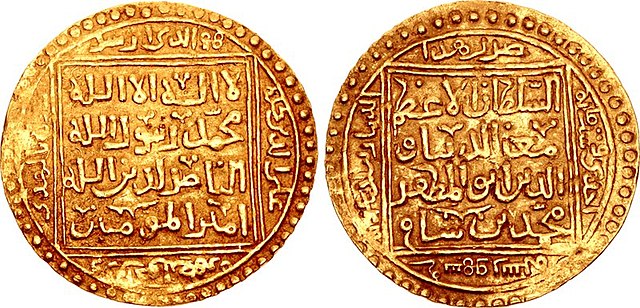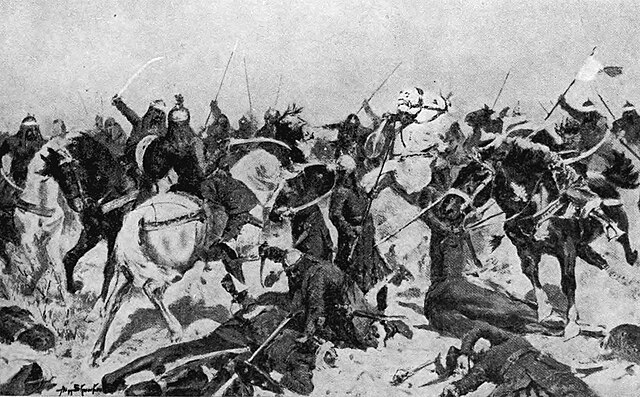Mu'izz ad-Din Muhammad ibn Sam, also known as Muhammad of Ghor or Muhammad Ghori, was a ruler from the Ghurid dynasty based in the Ghor region of what is today central Afghanistan who ruled from 1173 to 1206. Muhammad and his elder brother Ghiyath al-Din Muhammad ruled in a dyarchy until the latter's death in 1203. Ghiyath al-Din, the senior partner, governed the western Ghurid regions from his capital at Firozkoh whereas Muhammad extended Ghurid rule eastwards, laying the foundation of Islamic rule in South Asia, which lasted after him for nearly half a millennium under evolving Muslim dynasties.
Gold coin of Muhammad from Ghazni, for circulation in Central Asia and what is present-day Afghanistan
The last stand of Rajputs, depicting the Second Battle of Tarain in 1192
Bengal coinage of Bakhtiyar Khalji (1204-1206). Struck in the name of Mu'izz al-Din Muhammad, dated Samvat 1262 (1204). Obverse: Horseman with Nagari legend around: samvat 1262 bhadrapada "August, year 1262". Reverse: Nagari legend: srima ha/ mira mahama /da saamah "Lord Emir Mohammed [ibn] Sam".
Artistic description of Muhammad's assassination while offering evening prayers.
The Ghurid dynasty was a Persianate dynasty of presumably eastern Iranian Tajik origin, which ruled from the 8th-century in the region of Ghor, and became an Empire from 1175 to 1215. The Ghurids were centered in the hills of the Ghor region in the present-day central Afghanistan, where they initially started out as local chiefs. They gradually converted to Sunni Islam after the conquest of Ghor by the Ghaznavid ruler Mahmud of Ghazni in 1011. The Ghurids eventually overran the Ghaznavids when Muhammad of Ghor seized Lahore and expelled the Ghaznavids from their last stronghold.
Coinage of Mu'izz al-Din Muhammad. Dated AH 601 (1204/5 CE), Ghazni mint.
Fortress and Ghurid arch of Qala-e-Bost as printed on an Afghan banknote.
The last stand of Rajputs, depicting the Second Battle of Tarain in 1192
Bengal coinage of Turkic general Bakhtiyar Khalji (1204–1206 CE). Struck in the name of Mu'izz al-Din Muhammad, dated Samvat 1262 (1204 CE).





